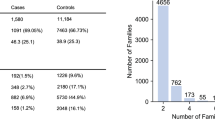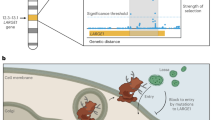Abstract
To test whether African ancestry is protective for severe dengue, we genotyped 49 hospitalized cases of dengue hemorrhagic fever (DHF) as well as 293 neighborhood cases of dengue fever and 294 asymptomatic controls in Salvador, Bahia, Brazil. Ancestry-informative markers and 282 unlinked SNPs not associated with the clinical presentation of dengue were used to estimate ancestry. After controlling for income, both self-defined Afro-Brazilian ethnicity and African ancestry were protective for DHF (P=0.02, OR=0.28 and P=0.02, OR=0.13, respectively). Income or an index of income indicators, however, was also independently associated with the diagnosis of DHF.
Similar content being viewed by others
Introduction
The epidemiology of dengue hemorrhagic fever (DHF) suggests that some ethnically defined populations differ in their susceptibility. In the Cuban dengue epidemics of 1981 and 2001, African ancestry appeared to be relatively protective for DHF and dengue shock syndrome, but not for classic dengue fever (DF).1 In Haiti, from 1994 to 1999, no cases of DHF were reported despite intense circulation of three serotypes,2 and although dengue virus circulates sporadically in Africa, there have been no reported epidemics of DHF.3 Socioeconomic factors also may influence the severity of dengue. In Asia, ethnic Chinese in Singapore show a higher attack rate for DHF compared to ethnic Malays and Asian Indians.4 In Trinidad, however, it was the Pakistani/Asian Indian population that appeared to disproportionately suffer severe disease.5 In each case, the economically more advantaged group was more affected. As income and ethnic background are interrelated, we tested these associations using self-declared ethnicity, genetic ancestry and income in Salvador, Bahia, Brazil.
Materials and methods
Population
The Bahia State Secretariat of Health identified 91 presumptive cases of grade II DHF during 2002 and 2003 in the capital city of Salvador by active surveillance of city hospitals. Of those, 31 met all World Health Organization diagnostic criteria6 (confirmed) and 34 met all criteria, except for documentation of hemoconcentration (suspected). Of those with confirmed or suspected DHF, 55 were contacted and agreed to participate in the study along with at least four neighbors who reported having classic dengue fever in 2002 (n=293) and four who reported to have never experienced symptoms of dengue (n=294). The controls were matched for age above or below 15, but not for sex.7 Demographic, socioeconomic and environmental data as well as 10 ml of blood were collected from all subjects. Written informed consent was obtained from participants and/or their guardians. The study was approved by the ethical review boards of University Hospitals of Cleveland, the Oswaldo Cruz Foundation, Bahia and the Brazilian National Commission on Ethics in Research.
Serology and genotyping
The Evandro Chagas Institute's Arbovirus Laboratory performed the dengue IgG ELISAs (positive=titer <1:40). Genomic DNA was genotyped by Illumina BeadArray (Illumina, CA, USA). Six replicates and two trios were used to guide the clustering and to calculate error rates. Two different analysts interpreted the genotyping results using GenCall software v. 6.2.0.4 (Illumina, CA, USA). For estimating ancestry, 30 ancestry informative markers (AIMs)8 and 282 unlinked SNPs not associated with the clinical presentation of dengue were genotyped.
Data analysis
Logistic regression was performed using SPSS v. 10 (SPSS Inc., IL, USA). Self-declared ethnicity followed categories (white, mixed, black, Indian/Asian) recognized by the Brazilian Census (Instituto Brasileiro de Geografia e Estatística-IBGE). ‘Income’ was reported in government-defined units of Monthly Minimum Salaries (1-MMS=US$97.03 in 2004). This was normalized by log10 (MMS+1) transformation. Income was further transformed into an index based on the sum of coefficients from linear regression of socioeconomic variables that were significantly correlated with log income.
Genetic ancestry was estimated with the program Structure 2.19 under the admixture model assuming independent population allele frequencies. The burn-in length was 10 000 with 100 000 iterations. The major populations of origin were European and African; therefore, two subpopulations (K=2) were modeled. Summary statistics indicated convergence, and the results from three runs were consistent. The ancestry estimates were graphed with the program DISTRUCT.10 Corresponding genotypes for 60 individuals from the Nigerian Yoruba ethnic group and 60 ethnic Caucasians (pseudoancestors) were obtained from the Hapmap Project database and included for comparison and to improve the ancestry estimates.11
Results
For each group, 8–11% were excluded for a negative dengue IgG ELISA. For DHF, 19 suspected and 30 confirmed cases were analyzed. The DF group had significantly lower income than any of the other groups, but age and sex distributions were similar for all. Mean income by ethnicity was similar to that reported by the IBGE for Salvador. Results did not differ significantly using either income or the income index (not shown). Results using the index will be presented, as this was available for all individuals compared to 87% for income.
The genotype calls for the two analysts were highly correlated (r=0.99±0.03), and genotyping was successful for 93.5% of the markers and 98.8% of the samples. The error rate was low by replicate (0.13%), sexual (0.01%) and Mendelian (0.07%) inconsistencies. Seven SNP genotypes using a primer extension method for 65 samples were consistent with the Illumina genotype results.
The mean African ancestry for the whole population differed significantly if AIMs alone (0.54), unlinked non-AIMs (0.42) or both markers (0.44) were used (all P's <0.001 by Student's t-test). Relative to the pseudoancestors, all ethnic groups had some degree of admixture (Figure 1).
When ethnicity was analyzed controlling for age, sex and income index, self-declared black ethnicity was significantly protective for DHF (Table 1). The association was primarily driven by comparing DHF with DF (P=0.02; OR=0.277). When only confirmed cases were considered, however, ethnicity was not significant for any comparison, perhaps due to sample size. Increasing income index increased risk and was the most consistent correlation.
An increasing percentage of genetic African ancestry was protective for DHF with or without controlling for the income index (Table 1). This association was also driven by the comparison of DHF with DF (OR 0.13). Income was significantly associated with all comparisons between DHF and DF, but not DHF and the asymptomatic group alone. The results did not differ significantly whether the analysis was conducted with only the AIMs or the non-AIMs (not shown).
Income and percent African ancestry were only weakly correlated (r2=0.12) and not collinear. The graph of the correlation between the income index and ancestry indicated two main income clusters. The poor were well represented by all degrees of African ancestry, but those better off were predominantly of European ancestry (Figure 2).
Discussion
In the Americas, the contribution of ancestral populations to an individual's genetic makeup is often complex and poorly captured by categorical descriptions, such as race or ethnicity. For DHF, the contribution of ancestry is important only in that it may suggest the presence of one or few major genes2, and these will be characterized by unequal distribution of polymorphisms depending on ancestral mixture.
For the population of Salvador, Brazil, dengue severity was significantly associated with both self-declared ethnicity and ancestry, especially when compared to individuals presenting with DF. That the comparison of DHF with DF produces the strongest genetic associations has been reported previously.12 The study also indicates that higher income, and by extension socioeconomic factors, is also strongly associated. Although rates of hospitalization may differ by income, we controlled for this variable.
Income-based differences in access to the health care system could explain how DHF might be associated with socioeconomic factors. DHF is a hospital-based diagnosis and may be made more frequently for economically advantaged individuals. In the USA, even where socioeconomic conditions are similar, utilization of the health care system may differ by ethnic group,13 and the same also occurs in Brazil.14 Finally, exposure to dengue may also differ by socioeconomic level and may help explain an association of DHF with income.15 Ancestry and income are important factors independently associated with the occurrence of DHF and must be considered as covariates in genetic studies of DHF.
References
de la CSB, Garcia G, Perez AB et al: Ethnicity and difference in dengue virus-specific memory T cell responses in Cuban individuals. Viral Immunol 2006; 19: 662–668.
Halstead SB, Streit TG, Lafontant JG et al: Haiti: absence of dengue hemorrhagic fever despite hyperendemic dengue virus transmission. Am J Trop Med Hyg 2001; 65: 180–183.
Gubler DJ : Dengue and dengue hemorrhagic fever. Clin Microbiol Rev 1998; 11: 480–496.
Guha-Sapir D, Schimmer B : Dengue fever: new paradigms for a changing epidemiology. Emerg Themes Epidemiol 2005; 2: 1.
Brown T, Babb K, Nimrod M, Carrington C, Salas R, Monteil M : A retrospective study of the 1996 DEN-1 Epidemic in Trinidad: demographic and clinical features. Dengue Bull 2004; 28: 7–19.
World Health Organization: Dengue Haemorrhagic Fever: Diagnosis, Treatment, Prevention and Control. Geneva: WHO, 1997.
Nguyen TH, Nguyen TL, Lei HY et al: Association between sex, nutritional status, severity of dengue hemorrhagic fever, and immune status in infants with dengue hemorrhagic fever. Am J Trop Med Hyg 2005; 72: 370–374.
Parra EJ, Kittles RA, Shriver MD : Implications of correlations between skin color and genetic ancestry for biomedical research. Nat Genet 2004; 36: S54–S60.
Pritchard JK, Stephens M, Donnelly P : Inference of population structure using multilocus genotype data. Genetics 2000; 155: 945–959.
Rosenberg NA : DISTRUCT: a program for the graphical display of population structure. Mol Ecol Notes 2004; 4: 137–138.
Tang H, Peng J, Wang P, Risch NJ : Estimation of individual admixture: analytical and study design considerations. Genet Epidemiol 2005; 28: 289–301.
Sakuntabhai A, Turbpaiboon C, Casademont I et al: A variant in the CD209 promoter is associated with severity of dengue disease. Nat Genet 2005; 37: 507–513.
Smith WR, Betancourt JR, Wynia MK et al: Recommendations for teaching about racial and ethnic disparities in health and health care. Ann Intern Med 2007; 147: 654–665.
Barata RB, de Almeida MF, Montero CV, da Silva ZP : Health inequalities based on ethnicity in individuals aged 15–64, Brazil, 1998. Cad Saude Publica 2007; 23: 305–313.
Vasconcelos PF, Lima JW, da Rosa AP et al: [Dengue epidemic in Fortaleza, Ceará: randomized seroepidemiologic survey]. Rev Saude Publica 1998; 32: 447–454.
Acknowledgements
This work was supported by NIH R21 AI056263. The authors thank Dr Niranjian Kanesa-thasan for his useful comments on serologies and the design of this project.
Author information
Authors and Affiliations
Corresponding author
Rights and permissions
About this article
Cite this article
Blanton, R., Silva, L., Morato, V. et al. Genetic ancestry and income are associated with dengue hemorrhagic fever in a highly admixed population. Eur J Hum Genet 16, 762–765 (2008). https://doi.org/10.1038/ejhg.2008.4
Received:
Revised:
Accepted:
Published:
Issue Date:
DOI: https://doi.org/10.1038/ejhg.2008.4
Keywords
This article is cited by
-
Genetic association study of interferon lambda 3, CD27, and human leukocyte antigen-DPB1 with dengue severity in Thailand
BMC Infectious Diseases (2020)
-
Molecular docking and QSAR theoretical model for prediction of phthalazinone derivatives as new class of potent dengue virus inhibitors
Beni-Suef University Journal of Basic and Applied Sciences (2020)
-
The effect of KIR and HLA polymorphisms on dengue infection and disease severity in northeastern Thais
Medical Microbiology and Immunology (2020)
-
Dengue fever in Dar es Salaam, Tanzania: clinical features and outcome in populations of black and non-black racial category
BMC Infectious Diseases (2018)
-
Transovarial transmission of DENV in Aedes aegypti in the Amazon basin: a local model of xenomonitoring
Parasites & Vectors (2017)





